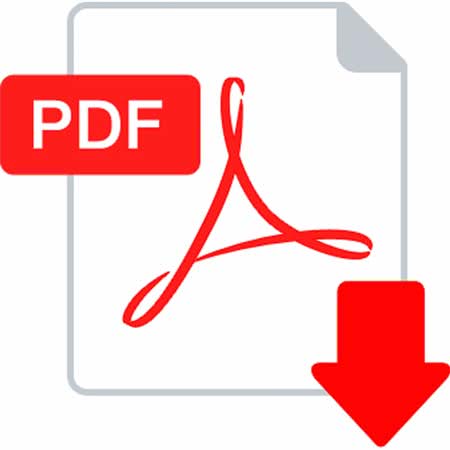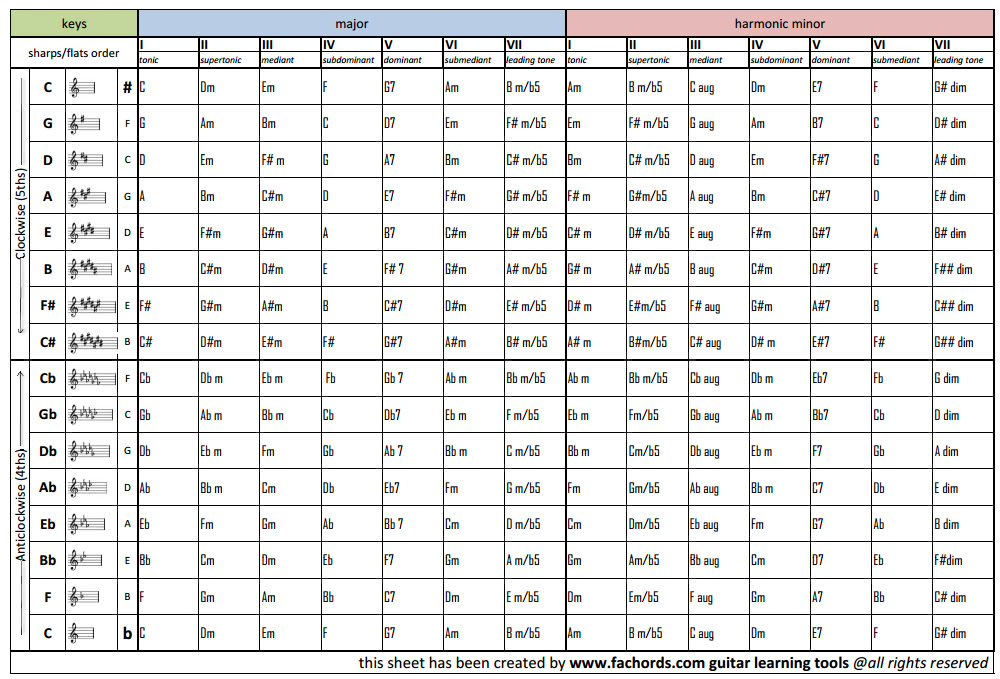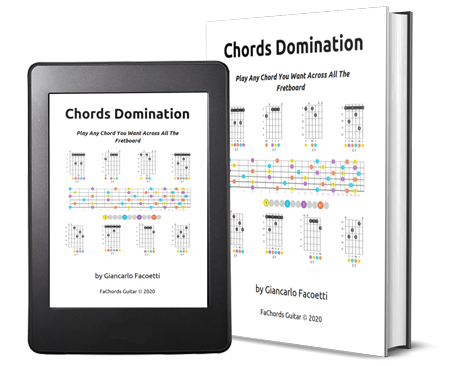
When approaching songs and chord progressions on guitar, it is useful to know how the music keys work .
There exist a number of different keys, 30 keys, to be precise; each tonality has its own specific chords , in this tutorial we're going to show you the chords for the most used keys in modern music.
There are also some clever strategies to identify the key of a song.
Be sure to download the chords in keys table with major and minor tonalities.
Just click the button below to access the free download area.
In the following, you find a list with the guitar chords in the most used major and minor keys .
For each tonality, the list of the chords belonging to that key is shown.
From a guitarist perspective, a key could be easy or difficult, depending on how many notes can be played with open string chords .
Having chords fingerings with open strings position is a a great advantage for many reasons : the fingerings are easier, and the sound of open strings are more brilliant and resonating.
Usually, we guitarists prefer keys with root, dominant and sub-dominant chords in open positions, as they are the most used chords in songs.
A useful tool to manage chords in keys is the Circle Of Fifths , we have created an interactive version that you can use in your browser.
The chords of a tonality are derived from its scale.
We can have major and minor scales , thus major or minor keys (actually, we have natural, melodic and harmonic minor, but for the purpose of this post we'll stick to natural minor scales only).
Depending on the degree of the note from which a given chord is created, the chord degree solves a function.
For example, the I degree, is the tonic , or root, that is the tonal center of the key .
The V degree is the dominant , which has a feeling of tension, often resolved by playing the root soon after.
In the table below you see the degree names and functions.
| I | II | III | IV | V | VI | VII |
|---|---|---|---|---|---|---|
| Tonic | Supertonic | Mediant | Subdominant | Dominant | Submediant | Leading tone |
Together with the E minor, the E major key is the easiest key for beginner guitar players.
Indeed, the root of this key, E, is on the lowest and highest string (1st E string and 6th E low strings).
The dominant of this key, the B, is on the 2nd open string.
So, within this key, beginners can exploit open strings a lot. A great song in the key of E major is " Lonely stranger " by Eric Clapton.
| Key | I | ii | iii | IV | V | vi | vii |
|---|---|---|---|---|---|---|---|
| E | E | F#m | G#m | A | B | C#m | D# dim |
We all know the G major chord is taken with open strings.
It's one of the easiest chords to play for beginners. A lot of folk tunes are in the key of G major.
A classic example is " Knocking On Heaven's Door " by Bob Dylan
| Key | I | ii | iii | IV | V | vi | vii |
|---|---|---|---|---|---|---|---|
| G | G | Am | Bm | C | D | Em | F# dim |
If the E minor key is the easiest for guitar players, the C major key is the easiest for pianists (only white keys!).
However, the C major key is easy also for guitar players because the dominant note, the G, is on the 3rd open string.
| Key | I | ii | iii | IV | V | vi | vii |
|---|---|---|---|---|---|---|---|
| C | C | Dm | Em | F | G | Am | B dim |
The D major key suits well to the guitar, because the I, V and IV degree (D, A and G) are on the open strings.
Popular songs in D major are " Crazy Little Thing Called Love " by Queen and " Lithium " by Nirvana.
| Key | I | ii | iii | IV | V | vi | vii |
|---|---|---|---|---|---|---|---|
| D | D | Em | F#m | G | A | Bm | C# dim |
The F major key is used a lot in folk music .
In this key, you can play the III, V and VI degrees (Am, C and Dm) in open strings position.
It's a great key for composing fingerstyle tunes .
| Key | I | ii | iii | IV | V | vi | vii |
|---|---|---|---|---|---|---|---|
| F | F | Gm | Am | Bb | C | Dm | E dim |
The A major is the key in which plenty of famous songs have been composed. For example, " Wild Thing " by The Troggs and " Alright Now " by Free.
You can play the tonic of this key, A major, and the dominant, E major on open strings; this makes the A major key easy and comfortable for guitarists .
| Key | I | ii | iii | IV | V | vi | vii |
|---|---|---|---|---|---|---|---|
| A | A | Bm | C#m | D | E | F#m | G# dim |
This is a great key for rock, punk and metal , as they use a lot of power chords.
For other genres, this key is not one of the easiest, unless you play many sub-dominant IV chords (E) that can be taken in open strings position.
| Key | I | ii | iii | IV | V | vi | vii |
|---|---|---|---|---|---|---|---|
| B | B | C#m | D#m | E | F# | G#m | A# dim |
This is a great key if you want to practice your bar chords !
In this key, there are not many open strings, even if the B note, that is on the 2nd open string, belongs to this tonality.
| Key | I | ii | iii | IV | V | vi | vii |
|---|---|---|---|---|---|---|---|
| F# | F# | G#m | A#m | B | C# | D#m | E# dim |
This one of the most difficult key for a guitar player .
In this key, you can't use the E, A and B open strings.
You can still find your way and try to exploit the D and the G open strings, that are present in the Bb major and Eb major chords of this tonality.
| Key | I | ii | iii | IV | V | vi | vii |
|---|---|---|---|---|---|---|---|
| Eb | Eb | Fm | Gm | Ab | Bb | Cm | D dim |
Do yourself a favour and don't use this tonality, if you want to play with a guitar.
This key is for brave jazz experimenters or guitarists in power-chords-only mode .
You can make this key easier by using a capo placed on the 1st fret.
| Key | I | ii | iii | IV | V | vi | vii |
|---|---|---|---|---|---|---|---|
| Ab | Ab | Bbm | Cm | Db | Eb | Fm | G dim |
The Bb tonality is loved by piano and saxophone players .
For us guitarists, is not so easy as the fingerings for the chords of this key are really complicated!
| Key | I | ii | iii | IV | V | vi | vii |
|---|---|---|---|---|---|---|---|
| Bb | Bb | Cm | Dm | Eb | F | Gm | A dim |
This key too does not have too many open strings that you could exploit to make your sound more brilliant.
But you could use this tonality for composing a grunge song , in the style of Nirvana!
| Key | I | ii | iii | IV | V | vi | vii |
|---|---|---|---|---|---|---|---|
| Db | Db | Ebm | Fm | Gb | Ab | Bbm | C dim |
Here's the easiest key for guitar players !
The E minor chord is really straightforward, as it has four open strings.
You can even play it with just the E, G and B open strings, without pressing any fret.
The E minor key is THE key for blues , rock and metal.
Jimi Hendrix, Stevie Ray Vaughan, Metallica and Deep Purple are aficionados of songs in E minor key.
| Key | i | ii | III | iv | v | VI | VII |
|---|---|---|---|---|---|---|---|
| E | Em | F# dim | G | Am | Bm | C | D |
The A minor key is perfect for the guitar.
The root (A) and the dominant (E) are on open strings.
A classic song in A minor key is " Stairway to Heaven " by Led Zeppelin.
| Key | i | ii | III | iv | v | VI | VII |
|---|---|---|---|---|---|---|---|
| A | Am | B dim | C | Dm | Em | F | G |
In the F# minor key we don't have the root and the dominant on open strings, but other chords of the key can be taken with some open strings, so this is a good key for the guitar.
A good example of songs in F# minor key is " I believe in a thing called love " by Darkness.
| Key | i | ii | III | iv | v | VI | VII |
|---|---|---|---|---|---|---|---|
| F# | F#m | G# dim | A | Bm | C#m | D | E |
The B minor key requires you to use bar chords often .
Indeed, the root and the dominant have a barrè on the 2nd fret.
Other chords of this tonality use open strings, such as Em, D and G.
| Key | i | ii | III | iv | v | VI | VII |
|---|---|---|---|---|---|---|---|
| B | Bm | C# dim | D | Em | F#m | G | A |
Have you ever watched the movie " This is Spinal Tap "? In this movie, Nigel Tufnel, guitarist for Spinal Tap, says that the D minor key is the saddest key .
And with a reason!
This is a great key for composing songs about lost loves and the like.
"Sultans of Swing" by Dire Straits has been composed in D minor.
| Key | i | ii | III | iv | v | VI | VII |
|---|---|---|---|---|---|---|---|
| D | Dm | E dim | F | Gm | Am | Bb | C |
The C# key is not often used in modern music .
For guitar players, is not too difficult; even if it has the root and the dominant to be played with bar chords, it has the E, A and B7 chords in open strings position.
" Moonlight Sonata " by Beethoven is composed in the key of C# minor
| Key | i | ii | III | iv | v | VI | VII |
|---|---|---|---|---|---|---|---|
| C# | C#m | D# dim | E | F#m | G#m | A | B |
This key has only the dominant note on the open strings (G).
For guitar players, this key is not a good match.
But you can always experiment with these chords and see what happens!
| Key | i | ii | III | iv | v | VI | VII |
|---|---|---|---|---|---|---|---|
| C | Cm | D dim | Eb | Fm | Gm | Ab | Bb |
The root and the dominant (G and D) are on open strings.
This key could be good for composing blues, jazz and rock songs. An example? " Texas Flood " by Stevie Ray Vaughan
| Key | i | ii | III | iv | v | VI | VII |
|---|---|---|---|---|---|---|---|
| G | Gm | A dim | Bb | Cm | Dm | Eb | F |
Not a good key for the guitar players, but there exists some exception: " Smell Like Teen Spirit " by Nirvana is in the key of F minor!
| Key | i | ii | III | iv | v | VI | VII |
|---|---|---|---|---|---|---|---|
| F | Fm | G dim | Ab | Bbm | Cm | Db | Eb |
This key is a little daunting for beginner guitar players , but it could be a good territory to explore in searching for new ideas
| Key | i | ii | III | iv | v | VI | VII |
|---|---|---|---|---|---|---|---|
| Bb | Bbm | C dim | Db | Ebm | Fm | Gb | Ab |
The Eb minor key is often used in lounge and jazz .
Someone says that this key has a relaxing and "sweet" feeling.
Not very easy for guitar players, unless you use a capo on the first fret and play the chords of the D minor tonality.
| Key | i | ii | III | iv | v | VI | VII |
|---|---|---|---|---|---|---|---|
| Eb | Ebm | F dim | Gb | Abm | Bbm | Cb | Db |
Definitely not a key good for guitar players.
However, the rule still applies: you should use this strange keys for inspiration ; by playing the uncomfortable chords of this kind of tonality, you could come up with new ideas!
| Key | i | ii | III | iv | v | VI | VII |
|---|---|---|---|---|---|---|---|
| Ab | Abm | Bb dim | Cb | Dbm | Ebm | Fb | Gb |

We have created a handy chart with all the chords for each key .
It will be useful in composition and for studying if you are approaching music theory.
This sheet gives you the big picture of the most used music keys .
It contains the chords generated from the major scale and the harmonic minor scales of each music key.
The keys are shown following the circle of fifths , so you can understand the patterns of the sharps/flats of the keys.
Starting from the C key, which has no sharps/flats, if you follow the circle of fifths clockwise, every next key has one added sharp (C has no sharp, G key has 1 sharp, D key has 2 sharps, and so on).
If you follow the circle of fifths anticlockwise, every next key has one more flat (C has no flat, F key has 1 flat, Bb has 2 flats, and so on).
The Circle Of Fifths is also useful when dealing with key changes.


Find all the resources you need, organized in a step-by-step program, to master chords, scales and progressions.
FaChords comprehensive guitar ebooks will help you advance your skills further.